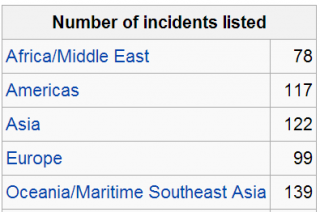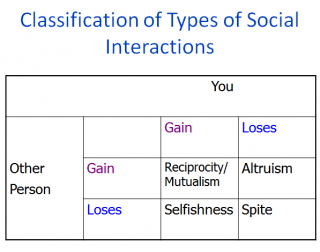Suicide
Running Amok: Why Are Virtually All Spree Killers Men?
An evolutionary psychology perspective: why virtually all spree killers are men.
Updated June 17, 2024
After the recent Sandy Hook Elementary School massacre of innocents, a friend of mine posted this question to his Facebook page: "Once again, we miss the obvious... It is boys and men who shoot, not girls and women! Mental illness aside... what is it about boys, men, and masculinity?"
In their 1988 book Homicide, Martin Daly and Margo Wilson defined this type of rampage killing as a "...frenzied homicidal rampage until (the killer is) killed or subdued." They too asked: " ...why don't women do the same?" (p. 156) in chapter 7 of their book, which is aptly titled Why Men not Women?
Spree Killers: Male, Generally Young, and Suicidal
Here is a partial list of school spree killing massacres from a Wikipedia article—as ranked by the number killed. Note that all of the perpetrators are male, and that most of them committed suicide at the end of their rampage. With two exceptions, the killers were in their twenties, or younger.

List of School Massacres (from Wikipedia: "http://en.wikipedia.org/wiki/List_of_rampage_killers#School_massacres")
Spree Killings Are Rare, But They Are a Cross-Cultural Phenomenon
A similar pattern is found in spree killings in cultures around the world. The table below lists spree killers in Asia. This top portion of the list is from the Wikipedia article, List of Rampage Killers, which also lists spree killers from various regions around the world. Again, we see the same general pattern: the spree killers are virtually always male, in their twenties or teens, and they most always end their spree by committing suicide, or they are killed by police.

List of Rampage Killings in Asia (from Wikipedia)
The fact that spree killing occurs in all cultures, albeit rarely, and the fact that it is a strongly sexually dimorphic phenomenon, are rather ominous indications that it is not simply the result of some type of cultural fluke (such as a "spree killing culture" operating on a blank slate mind/brain). Instead, these facts suggest that it is a rare manifestation of some aspect of human nature. In particular, male nature.

Spree Killing Is a Cross Cultural Phenomenon
The Young Male Syndrome
Daly and Wilson (1988) noted that spree killing (also called running amok, rampage killings, or "going postal") is a rare phenomenon, but when it happens the perpetrator is virtually always male. This suggests that it is a manifestation of a sex difference of the greater general male tendency toward physical violence. Someting happens to males at about age 14 that doesn't happen to girls. The sex difference in committing homicides really starts to explode on the graph (see the graphic). From age 14 onward, the rate at which males begin to murder others begins to far outstrip that of females. It peaks when males are in their mid-twenties, and then it starts to decline. Although the graph is based on Canadian data, this same general pattern with respect to the sex and age of murderers is seen around the world. Even in cultures widely separated in space and time, the graph looks pretty much the same.

Homicide Rate by Age and Sex (Daly & Wilson, 2001)
What would motivate anyone to start killing innocent strangers, often for no apparent reason, is beyond the ability of most of us to fathom. Our empathy is for the victims; we feel deep disgust, anger and contempt toward the perpetrator. His actions seem impossible to understand.
However, researchers and policy makers at some point must step beyond their own feelings of disgust and outrage to try to understand why this happens. A good scientific understanding of what causes someone to "go postal" may eventually help professionals to better identify any early warning signs. They may be able to develop interventions for individuals who may be close to the edge of running amok. And, a sophisticated understanding of the phenomenon will also shed light on these sex differences: Why men, not women? Why predominantly young men? Why does the spree typically end with suicide (or "suicide by cop")?
Human Nature: The Puzzle of Spite
In most all interactions with someone else, both you and the other person can either gain or lose from the encounter. From an evolutionary perspective, selfishness, altruism toward genetic kin, and reciprocity with non-kin make sense—all can help you to propagate your genes into the next generation (which increases your inclusive fitness—the "bottom line" in the scorecard of evolution).

But why does spite exist? Spite occurs when both you and the other person lose from an interaction. As noted by Richard Dawkins in his classic book The Selfish Gene, initially the existence of spite appeared to be something of an evolutionary puzzle. Why would anyone engage in spite, and hurt themselves by doing so?
Spree killing is an extreme example of spite. As noted earlier, the killer himself virtually always dies at the end of the rampage.
And, on a far lesser scale, ask yourself this question: Have you ever done something out of spite—something that you did on purpose to hurt your target, but, that also hurt you? Most of us have done something spiteful at some point in our lives. The motive is typically revenge—to redress some perceived injustice against us, even if we hurt ourselves further in the process.
The Dark Side of Human Nature: The Relativity of Inclusive Fitness
There is a dark side to evolution that allows for behavioral predispositions for spite to remain in the gene pool.
If evolution "wants" you to copy as many of your genes into the next generation, having a lot of children is the obvious solution. However, inclusive fitness is relative, not absolute. That is, nature doesn't "say" (absolute inclusive fitness): "Have 2 kids (or help 4 full sibs), and then you can stop. Good job! You did your genetic duty, and you may pass along now..." Instead, nature "says" (relative inclusive fitness): "Out-reproduce your competitors. Your competitors are all of the genes in your species' gene pool that you do not share. If the average inclusive fitness score is 4, then you go for 5... " In other words, our psychological adaptations are designed to not just "keep up with the Joneses" but to genetically "do better than the Joneses."
Now, here is where the nasty part of nature, including human nature, comes in. An unfortunate corollary of the relativity of inclusive fitness is that an organism can also increase its inclusive fitness by reducing the inclusive fitness of others. Reducing the proportion of others' (non-kin) genes in the gene pool will increase the proportion of yours. That potentially makes murder, genocide, warfare, and other nasty stuff potential relative genetic pay offs. This suggest that human nature includes some nasty psychological adaptations that, when triggered by certain circumstances, can result in homicidal behavior, including spree killings.
Why Is Male Nature More Homicidal Than Female Nature?
Brief answer: because in an evolutionary sense, males are more desperate.
In my previous blog post, Which Sex is Playing a Higher Stakes (Reproductive) Game?, I noted that men have greater reproductive variance than do women. That is, there is more variability among men than women with respect to the number of children that they have.

Sex Differences in Reproductive Variance
As I noted in that post, there are two groups of men for which there are no female equivalents: males who are "reproductively disenfranchised" (excluded by the opposite sex from reproduction) at the low end of the distribution, and males who win a "reproductive jackpot" at the high end (produce many offspring—the documented world record number is 888 children sired by one man).
However, at the low end, there are indeed some men with whom no woman would want to risk a pregnancy. Some men are just so unappealing (unattractive, stupid, poor, in poor health, and apparently with lousy genes) that no woman would want to have sex with him. No woman would choose that man to be the father of her children. Imagine a homeless man, empty whiskey bottle in hand, sleeping in a urine stained cardboard box. Any takers? These guys are not happy campers. They are losing out in the most important biological game of life.
Many spree killers fall into this category, or, they so perceive themselves. Spree killings often follow a personal rejection by a female(s), and, the perception that more rejections are likely to follow perhaps due to social ostracism or loss of social status. Daly and Wilson (1988, p. 280) note that "The most common precipitating events are difficulties with wives or girlfriends, losses of face, and losses of money..."
Male Paternity Insecurity: Mommy's Babies are Daddy's Maybes
Another evolutionary challenge for human males is that, unlike women, men have never been absolutely certain whether a particular child is genetically their own (with the modern exception of DNA paternity testing that is available today). In contrast, women never have had such doubts. Any child they bear is certainly her genetic offspring. This sex difference also extends to extended genetic relatives—we are more confident that the offspring of our female, rather than male, relatives share our genes. Thus, women typically perceive that they have genetic kin who could benefit from their assistance. This may help to explain the sex difference in suicide rates.
The Male Suicide Rate is 3 to 4 Times The Rate for Women
As noted earlier, spree killings most often end with suicide (or "suicide by cop").
One evolutionary theory of suicide is that it is more likely to occur when a person feels that their future prospects are extremely bleak, they feel ostracized and isolated, and they perceive that they are a net burden on genetic relatives (thus reducing their relatives' inclusive fitness). Several factors may help to provide ultimate (evolutionary) explanations for the higher rate of male suicide: (a) male paternity uncertainty, noted above, may result in males feeling less of a connection to putative genetic relatives, and (b) more males than females are at the lower end of the reproductive variance distribution (i.e., "reproductively disenfranchised") such that their perceived future prospects are dismal.
Male Tribal Warfare: Violence Between In- vs- Out Groups
Virtually all spree killers are men, and virtually all tribal and national warfare combatants are, and have been, male. Some rampage killers may perceive that they are embedded in and surrounded by members of a hostile out-group "tribe."
Daly and Wilson (1988, p 280) noted that:
The young man who runs amok is typically residing far from home, often for the first time in his life. He has typically been brooding over failure. One cannot but wonder if his psychology is that of a doomed warrior, surrounded by enemies and determined at least to inflict some costs upon them.
Rampage Killing as a Manifestation of Sexually Dimorphic Psychological Adaptations
So, why men, not women? We may now have some possible answers.
A spree killing may be an act of extreme spite that decreases the relative reproductive success of non-kin competitors by killing them (especially members of an out-group "tribe"), and thus increases the relative inclusive fitness of the killer's genetic kin. Also, the suicide of the killer may decrease real or perceived burdens on his genetic relatives due to his perceived low status and dismal future reproductive prospects. In ancestral environments, being ostracised or ejected from one's tribe could amount to a death sentence. Exacting retribution against the perceived injustice of group ostracism may also be a contributing motive.
In general, males may be more predisposed toward violent conflicts ultimately due to their greater reproductive variance (the foundational evolutionary pressure behind the evolution of male psychological adaptations for greater risk-taking, violence and status seeking). Male low levels of assurance of genetic parentage may exacerbate their self-perceived poor reproductive prospects, which may further increase already high intrasexual competition pressures.
Of course, this is a cold technical analysis that doesn't fit with well with our daily "folk psychology" conceptions of human behavior. And, some of these explanations may seem about as non-intuitive as quantum physics. But, as with quantum physics, it is the underlying mathematics, the foundational theory, and the level of empirical corroboration that may help us to develop a sound scientific understanding of rampage killing—a horrifying and otherwise deeply puzzling phenomenon.
If we are to have a realistic hope of reducing the darkest aspects of human behavior we must first be willing to face, and then work to develop an accurate scientific understanding of, the deep evolutionary forces that have molded and that underlie human nature.
Recommended reading:
Daly, M., & Wilson, M. (1988). Homicide. NY: Aldine de Gruyter.
Wilson, M. & Daly, M. (1985) Competitiveness, risk-taking and violence: the young male syndrome. Ethology and Sociobiology, 6, 59-73. [Reprinted in DT Kenrick & CL Luce, eds. (2004) The functional mind: readings in evolutionary psychology Boston MA: Pearson.] PDF
Daly M., & Wilson, M. (2001) Risk-taking, Intrasexual Competition, and Homicide. Nebraska Symposium on Motivation, 47, 1-36. PDF
(c) Copyright Michael Mills




